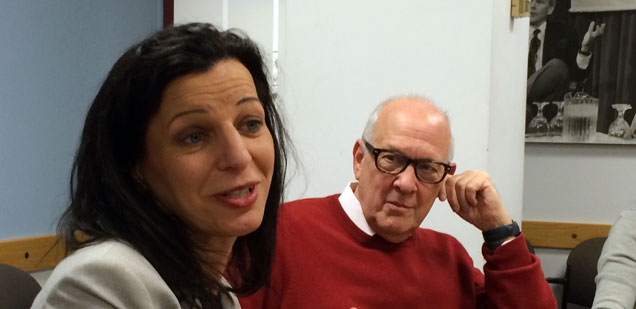March 31, 2015 — Juliette Kayyem, who has worked in homeland security at the state and federal level, provided advice on communicating about national security and public safety issues.
Kayyem was the Assistant Secretary for Intergovernmental Affairs in the U.S. Department of Homeland Security and the first Undersecretary for Homeland Security for the Commonwealth of Massachusetts. She ran for governor of Massachusetts in 2013-14. Additionally, she has worked as a columnist for The Boston Globe and as an on-air analyst for CNN, and is a lecturer on public policy at HKS.
Kayyem stressed that when communicating about matters of national security, the government needs to acknowledge the fact that “stuff happens,” and that public safety can never be 100% assured. “Something that we sold the public, and in many ways in the early days after 9/11, sold the media, was this notion of perfect security or invulnerability…never again, this will not happen again,” she said.
In retrospect, Kayyem said this stance was delusional and unhelpful. Since then, numerous vulnerabilities – such as Hurricane Katrina and the government response that followed – have eroded the idea of flawless national safety.
Kayyem provided some points for consideration when communicating in the wake of a national security or public safety incident, for both the government and the media:
- There are black swans. “There are just random events that no amount of creativity or planning or nimbleness…can stop.” In these instances, government and media should also be sure to focus on what lessons were learned, the response, and how responses can be improved in the future.
- The standards of success are not binary in security. Government agencies should communicate what success looks like. During the cleanup response to the BP oil spill, “the public and the media had the notion that if oil hits shore, that’s failure. No. Less oil hitting shore is success,” said Kayyem regarding federal government cleanup efforts after the spill – and the fact that it was not possible to contain all of the oil spilled.
- Layered defenses and redundancies. When covering systems that have failed – or systems that work – Kayyem said that interesting stories can be found by asking “how are those layered defenses working, how are those redundancies being built?” not only for threats such as terrorism, but also for issues such as climate change, guns and pandemics.
- Public engagement is key, not only as a communications strategy, but as an operational strategy. Kayyem discussed Occupy Sandy efforts to help people find homes after the hurricane, and Airbnb’s efforts to find housing for first responders. “I don’t view that as antagonistic,” said Kayyem. Instead, she views it as a success if government can empower others and “embrace the public engagement spirit not simply as ‘we’re going to tell you what to do,’ but actually absorb people’s enthusiasm for helping each other.”
- Tell stories as you would tell them to your friend at the kitchen table. Both government and media need to tell stories in an honest, relatable way. Kayyem discussed a story in which her cousin, Karen, was considering cancelling her daughter’s upcoming trip to New York City because of media coverage of the upcoming 10 year anniversary of 9/11. She wanted to know if Kayyem would send her children. “It was an illuminating moment,” she said, “because it was so honest. What we had failed to do was to relate to someone like Karen.”
Hear Kayyem discuss soft targets, infrastructure deficiencies, the Boston Marathon bombing, and security for Boston’s bid for the Olympics in the full audio recording posted above.
Article and photo by Nilagia McCoy of the Shorenstein Center.


